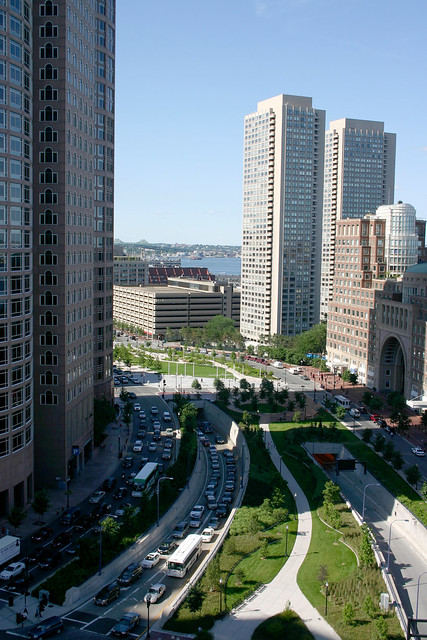The first time I read this book, I originally picked it up from the library along with The Image of the City by Kevin Lynch, a contemporary of Jacobs. I began reading Lynch's book first. Several days later, I happened to open the first page of Death and Life, just to see what it was like. I couldn't put it down. I finished several chapters that afternoon. Her writing style is incredibly compelling and bold. Consider the very first sentence: "This book is an attack on current city planning and rebuilding." She wanted to show people that modern city planning was to science what bloodletting was to medicine. More from the introduction:
There is a wistful myth that if only we had enough money to spend--the figure is usually put at a hundred billion dollars--we could wipe out all our slums in ten years, reverse decay in the great, dull, gray belts that were yesterday's and day-before-yesterday's suburbs, anchor the wandering middle class and its wandering tax money, and perhaps even solve the traffic problem.
But look what we have built with the first several billions: Low-income projects that become worse centers of delinquency, vandalism and general social hopelessness than the slums they were supposed to replace. Middle-income housing projects which are truly marvels of dullness and regimentation, sealed against any buoyancy or vitality of city life. Luxury housing projects that mitigate their inanity, or try to, with a vapid vulgarity. Cultural centers that are unable to support a good bookstore. Civic centers that are avoided by everyone but bums, who have fewer choices of loitering places than others. Commercial centers that are lackluster imitations of standardized suburban chain-store shopping. Promenades that go from no place to nowhere and have no promenaders. Expressways that eviscerate great cities. This is not the rebuilding of cities. This is the sacking of cities.
 |
| Boston's West End, July 1958 (source) |
 |
| The West End, demolished, by September 1960 (source) |
The introduction also covers the sources of various influences in city planning, from the Garden City visions of Ebenezer Howard to the Radiant City Utopian monstrosity of Le Corbusier. Reading her descriptions of their ideas, I began to realize just how far they had penetrated into our society. Cities designed to look pretty from an airplane. Massive highway projects cutting through neighborhoods. High-rise residential towers with humongous parking lots. A fanatical devotion to the notion of "open space" at all costs, and grass everywhere. Separation of uses: residential here, commercial over there. Free parking as a birthright. You can trace much of this kind of thinking back to some authors from the 19th and early 20th century. A reaction against the problems of cities, especially back then, when health and sanitation were minimal. Their solutions were designed, regardless of intention, to destroy cities. To fix the problems of cities by ripping them apart and re-creating them according to some kind of orderly and sterile vision. That these ideas became the foundation of the field of city planning is a scandalous shame.
Jacobs introduced this background to contrast their approach with hers. She was not interested in an ideology which dictated the right answers. She wanted to learn the principles behind successful cities, and the failures of others, through observation and investigation of the reality of cities. As she wrote:
I hope any reader of this book will constantly and skeptically test what I say against his own knowledge of cities and their behavior. If I have been inaccurate in observations or mistaken in inferences and conclusions, I hope these faults will be quickly corrected.
 |
| Skyscrapers, open space, and highways (source) |
Many people do not want to have to think about issues of urban planning. They just want to get on with their lives and leave planning to the experts. But Jane Jacobs exposes the so-called experts as charlatans, with little useful knowledge, and a hideous history of malpractice behind them. Instead she implores readers to look for themselves, and "also listen, linger and think about what you see." As people, we live in cities, and are economically dependent upon cities. We cannot escape their importance, and so it behooves us to pay attention to their vitality.
Great observations on the book. I think I've spent more time consulting it and re-reading it as a reference than I took actually getting through it in the first place. Have you also read Herbert Gans' book on the (former) West End, "The Urban Villagers"?
ReplyDeleteI did spend some time looking for that over the summer, but I didn't end up buying it. Amazon has some chapters online so I read those.
Delete